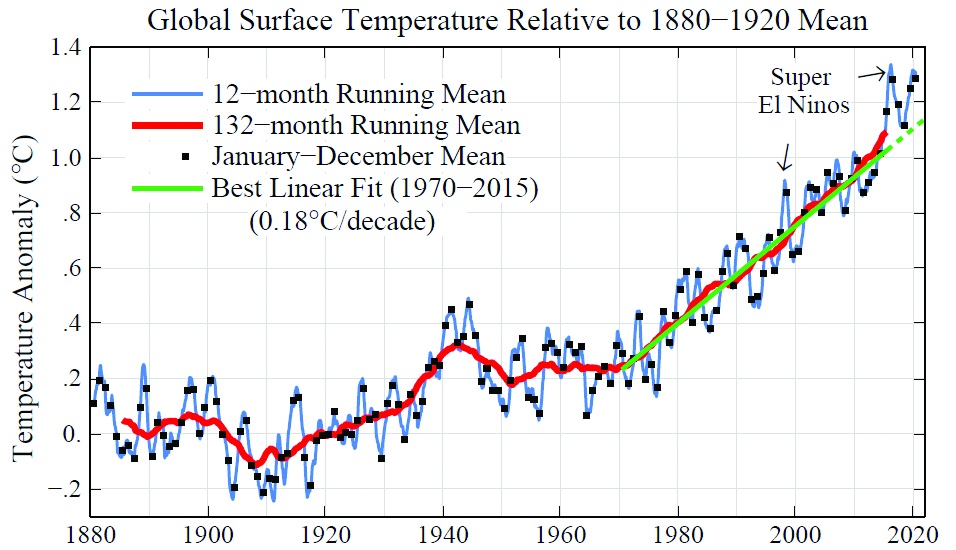It capped the warmest decade on record
George Harvey
In mid-January, a report by James Hansen et al. was posted at the Columbia University web site. “Global Temperature in 2020” makes clear that each of the last six years is one of the hottest six years ever recorded. The hottest year had been 2016, when an El Niño exacerbated the heating. Now, 2020 has at least tied that record, even though a La Niña cooled things somewhat (http://bit.ly/Global-temp-2020).
The Hansen report also show that the heating trend has persisted for decades, as the graph shows. Since the 1970s every decade set a new record as the hottest on record. Please consider this:
-
The decade of 1971 to 1980 was considerably warmer than the decade before it.
-
The decade of 1981 to 1990 was hotter yet and set a record as the warmest ever.
-
The decade of 1991 to 2000 broke that record and became the warmest ever.
-
The decade of 2001 to 2010 broke that record and became the warmest ever.
-
The decade of 2011 to 2020 broke that record and became the warmest ever.
The pattern is unmistakable. It also presents a problem. As the Earth has warmed, the effects of warming have become increasingly alarming. The damage from climate change is already dangerous. There may still be hope, but to realize that hope, we will have to act.
The previous edition of Green Energy Times had the article, “Climate Change Is Pushing Record-Setting Disasters” (http://bit.ly/GET-record-disasters). It speaks to a year in which record after record was broken. The year had the greatest number of named storms in the Atlantic hurricane season. Twelve named storms made landfall on the contiguous U.S. The previous record was nine.
NOAA published a brief report, “U.S. 2020 Billion-Dollar Climate Disasters,” providing a list of weather events that did over $1 billion in damages (adjusted for inflation) in the U.S. There were 22 of them in 2020, breaking a previous record of 16. Seven of them were named Atlantic storms, three were tornado outbreaks, two were severe hail storms, eight were other severe weather events, one was a drought, and the fires in the western U.S. counted for one (www.ncdc.noaa.gov/billions).
With 22 billion-dollar events, 2020 was the sixth year in a row having ten or more. The period of 1980 to 2000 had an average of seven per year. The total cost of weather-related disasters is more than double the average for the last 41 years. We were lucky, because for all the storms we had, none hit a major city. The damage could have been far worse. Nevertheless, the effects on our economy are growing rapidly.
One more thing NOAA made clear is that the economic cost of climate change is increasing rapidly. The cost of weather disasters in the 1980s averaged $17.8 billion, adjusted for inflation. Since then, it has risen consistently. Over the last five years, it averaged $121.4 billion.
Other parts of the world also have problems, of course. The last intact ice shelf in the Canadian Arctic collapsed, losing an area bigger than Manhattan because the sea and air were both unusually warm. Unfortunately, what is “normal” is changing.
The cause of the increase in big, damaging events is a seemingly small increase in global temperatures that is still less than the 1.5°C we have set as a limit to avoid dangerous climate change. Unfortunately, 1.5°C is a temperature rise we are rapidly approaching and soon will pass. As we put more carbon dioxide, methane, and other greenhouse gases (GHGs) into the atmosphere, the temperature of the Earth’s surface goes up.
Michael Mann is the scientist who showed us the “hockey stick curve” in a paper published in 1999. He is also known for testifying before a congressional committee that the consensus that climate change is real is the same among climate scientist as the consensus that gravity exists is among physicists.
Now, Mann has addressed a real difference of opinion among climate scientists. While many say that the Earth will continue to heat up for decades or centuries after we stop emitting GHGs, Mann asserted in an interview with The Guardian last October that he was confident climate change will slow down very quickly once we stop emitting GHGs, provided we do it soon enough. Please note two things, however: We must act soon enough. And acting will stop things from getting worse, not reverse the damage that has already been done (http://bit.ly/Guardian-Mann).
There are scientists who disagree with Mann, but he might be right, and that gives us hope. Even if he is wrong, we have to act to prevent the worst of climate change. If we get very proactive about eliminating GHG emissions, we really might be able to save the planet, and our children’s futures with it. But to do that, we must act quickly.
To stop climate change, we need to free ourselves from fossil fuels, which means using electric vehicles and heat pumps. The electricity we use will have to be from renewable sources and technologies. We need to stop using plastics based on petrochemicals. We can choose low impact clothing, food, and other goods. We have to support the legislation it takes to get there. We have to do these things as quickly as possible.










Leave a Reply